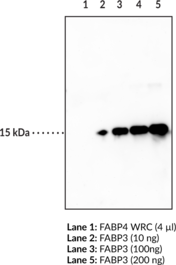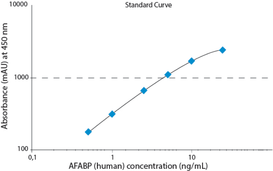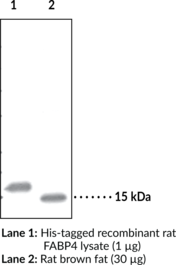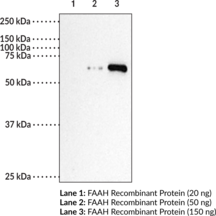Cayman
Showing 20401–20550 of 45550 results
-
immunogen: Synthetic peptide from human FABP3 amino acids 44-55 • Host: mouse • Species Reactivity: (-) Mouse FABP1, FABP2, FABP4 • Cross Reactivity:(+) Human and Rat FABP3, (−) mouse FABP3 • Application(s): WB
Brand:CaymanSKU:10233- 1 eaFatty acid binding protein 3 (FABP3) is one of nine known cytosolic FABPs ranging in size from 14-15 kDa containing 127-132 amino acids.{11979} Members of this protein family exhibit high affinity for small lipophilic ligands and were named according to the tissue from which they were initially isolated.{11979} Studies suggest that FABPs are involved in the uptake and metabolism of fatty acids, in the maintenance of cellular membrane fatty acid levels, in intracellular trafficking of these substrates, in the modulation of specific enzymes of lipid metabolic pathways, and in the modulation of cell growth and differentiation.{11977} FABP family members have highly conserved three dimensional structures and 22-73% amino acid sequence similarity. FABP3 is composed of ten antiparallel β strands that form a barrel and is the most widely distributed FABP. It is found in heart, skeletal and smooth muscle, mammary epithelial cells, aorta, distal tubules of the kidney, lung, brain, placenta, and ovary. FABP3 is a potential biomarker for myocardial injury, especially for early detection of acute myocardial infarction (AMI).{11979}
Brand:CaymanSKU:10233 - 1 eaAvailable on backorder
immunogen: Synthetic peptide from human FABP3 amino acids 44-55 • Host: mouse • Species Reactivity: (-) Mouse FABP1, FABP2, FABP4 • Cross Reactivity:(+) Human and Rat FABP3, (−) mouse FABP3 • Application(s): WB
Brand:CaymanSKU:10233- 1 eaAvailable on backorder
Brand:CaymanSKU:10010318 - 1 eaAvailable on backorder
Fatty acid binding protein 4 (AFABP; adipocyte FABP; FABP4) is a 15 kDa member of the intracellular FABP family, which is known for the ability to bind fatty acids and related compounds (bile acids or retinoids). AFABP is expressed in a differentiation-dependent fashion in adipocytes and is a critical gene in the regulation of the biological function of these cells. In mice, targeted mutations in FABP4 (gene also called: aP2) provides significant protection from hyperinsulinemia and insulin resistance in the context of both dietary and genetic obesity. AFABP is also expressed in macrophages where it modulates inflammatory responses and cholesterol ester accumulation. Total or macrophage-specific FABP deficiency confers dramatic protection against atherosclerosis in apoE-/- mice. These results indicate a central role for AFABP in development of metabolic diseases through its distinct actions in adipocytes and macrophages. This Enzyme Immunometric Assay (EIA) is based on a double-antibody sandwich technique. The wells of the plate supplied with the kit are coated with a goat polyclonal antibody specific of human AFABP. This antibody will bind any human AFABP introduced in the wells (sample or standard). [Bertin Catalog No. A05181]
Brand:CaymanSKU:10007614 - 96 wellsAvailable on backorder
Fatty acid binding protein 4 (Adipocyte-FABP, aP2, FABP4) is one of nine known cytosolic fatty acid binding proteins ranging in size from 14-15 kDa containing 127-132 amino acids.{11979} FABP4 is highly expressed in adipocytes and is regulated by peroxisome-proliferator-activated receptor-γ (PPARγ) agonists, insulin and fatty acids. Recent studies using FABP4 gene deletion in mice indicate a dominant role for FABP4 in several chronic metabolic diseases. Therefore, inhibiting the function of FABP4 is a potential mechanism for the treatment of metabolic diseases like diabetes and atherosclerosis.{14840,12286} Cayman’s FABP4 Ligand Binding Assay Kit provides a simple, reproducible, and sensitive tool for the identification of FABP4 ligands. The assay makes use of a Detection Reagent that exhibits increased fluorescence at 500 nm when bound to FABP4. Any strong ligand and/or inhibitor of FABP4 will displace the Detection Reagent thereby reducing the fluorescence. FABP4 is provided in high purity and in sufficient quantity for 100 tests.
Brand:CaymanSKU:10010231 - 1 eaAvailable on backorder
Immunogen: Synthetic peptide from the C-terminal region of human FABP4 • Host: Rabbit • Cross Reactivity: (+) Human, mouse, and rat FABP4; (−) FABP3 and FABP5 • Applications: IF, IHC, and WB
Brand:CaymanSKU:10004944- 1 eaAvailable on backorder
Immunogen: Synthetic peptide from the C-terminal region of human FABP4 • Host: Rabbit • Cross Reactivity: (+) Human, mouse, and rat FABP4; (−) FABP3 and FABP5 • Applications: IF, IHC, and WB
Brand:CaymanSKU:10004944- 1 eaFABP4 is primarily expressed in adipocytes but is also expressed in activated macrophages, indicating that the protein plays a critical role in foam cell formation and thus atherosclerosis.{12288,12286} FABP4 was first purified from mouse 3T3-L1 adipocytes and then from human adipocytes and was named ALBP.{12291,12290} The expression of FABP4 is developmentally regulated by fatty acids, PPARγ agonists, and insulin.{12292,12285} In mice, deficiency of FABP4 prevents the development of hyperinsulinemia and insulin resistance in genetic and diet-induced obesity.{3423,12287}
Brand:CaymanSKU:10004944 - 1 eaAvailable on backorder
FAD is a flavin dinucleotide that is synthesized when the AMP moiety from ATP is transferred onto riboflavin 5′-monophosphate (Item No. 18167).{38399} FAD functions as a coenzyme that facilitates the transfer of electrons by flavoenzymes in oxidation-reduction reactions in cells.{38400} FAD (0.0125-0.05% solution) reduces UV-B-induced death of human corneal epithelial cells in vitro.{38401}
Brand:CaymanSKU:23386 - 100 mgAvailable on backorder
FAD is a flavin dinucleotide that is synthesized when the AMP moiety from ATP is transferred onto riboflavin 5′-monophosphate (Item No. 18167).{38399} FAD functions as a coenzyme that facilitates the transfer of electrons by flavoenzymes in oxidation-reduction reactions in cells.{38400} FAD (0.0125-0.05% solution) reduces UV-B-induced death of human corneal epithelial cells in vitro.{38401}
Brand:CaymanSKU:23386 - 250 mgAvailable on backorder
FAD is a flavin dinucleotide that is synthesized when the AMP moiety from ATP is transferred onto riboflavin 5′-monophosphate (Item No. 18167).{38399} FAD functions as a coenzyme that facilitates the transfer of electrons by flavoenzymes in oxidation-reduction reactions in cells.{38400} FAD (0.0125-0.05% solution) reduces UV-B-induced death of human corneal epithelial cells in vitro.{38401}
Brand:CaymanSKU:23386 - 50 mgAvailable on backorder
FAD is a flavin dinucleotide that is synthesized when the AMP moiety from ATP is transferred onto riboflavin 5′-monophosphate (Item No. 18167).{38399} FAD functions as a coenzyme that facilitates the transfer of electrons by flavoenzymes in oxidation-reduction reactions in cells.{38400} FAD (0.0125-0.05% solution) reduces UV-B-induced death of human corneal epithelial cells in vitro.{38401}
Brand:CaymanSKU:23386 - 500 mgAvailable on backorder
Fadrozole is a non-steroidal aromatase inhibitor (IC50s = 5 and 1.4 nM for human placental and rat ovarian microsomal aromatase, respectively).{38819,38820} It selectively inhibits estrogen over progesterone production induced by luteinizing hormone (LH) in hamster ovarian tissue as well as corticosterone and aldosterone production induced by adrenocorticotropic hormone (ACTH; Item No. 24257) in rat adrenal tissue (IC50s = 0.03, 160, 100, and 1 μM, respectively).{38819} It also decreases ovarian estrogen levels in rats when administered at a dose of 0.26 mg/kg.{38820} Fadrozole inhibits conversion of cholesterol to 27-hydroxycholesterol by the cytochrome P450 (CYP) isomer 27A1 (Ki = 4.6 μM).{38821} It inhibits growth of androstenedione-stimulated mammary D2 cells implanted into thoracic mammary fat pads of mice by 95% when administered at a dose of 0.5 mg per animal per day.{38822}
Brand:CaymanSKU:24272 - 1 mgAvailable on backorder
Fadrozole is a non-steroidal aromatase inhibitor (IC50s = 5 and 1.4 nM for human placental and rat ovarian microsomal aromatase, respectively).{38819,38820} It selectively inhibits estrogen over progesterone production induced by luteinizing hormone (LH) in hamster ovarian tissue as well as corticosterone and aldosterone production induced by adrenocorticotropic hormone (ACTH; Item No. 24257) in rat adrenal tissue (IC50s = 0.03, 160, 100, and 1 μM, respectively).{38819} It also decreases ovarian estrogen levels in rats when administered at a dose of 0.26 mg/kg.{38820} Fadrozole inhibits conversion of cholesterol to 27-hydroxycholesterol by the cytochrome P450 (CYP) isomer 27A1 (Ki = 4.6 μM).{38821} It inhibits growth of androstenedione-stimulated mammary D2 cells implanted into thoracic mammary fat pads of mice by 95% when administered at a dose of 0.5 mg per animal per day.{38822}
Brand:CaymanSKU:24272 - 10 mgAvailable on backorder
Fadrozole is a non-steroidal aromatase inhibitor (IC50s = 5 and 1.4 nM for human placental and rat ovarian microsomal aromatase, respectively).{38819,38820} It selectively inhibits estrogen over progesterone production induced by luteinizing hormone (LH) in hamster ovarian tissue as well as corticosterone and aldosterone production induced by adrenocorticotropic hormone (ACTH; Item No. 24257) in rat adrenal tissue (IC50s = 0.03, 160, 100, and 1 μM, respectively).{38819} It also decreases ovarian estrogen levels in rats when administered at a dose of 0.26 mg/kg.{38820} Fadrozole inhibits conversion of cholesterol to 27-hydroxycholesterol by the cytochrome P450 (CYP) isomer 27A1 (Ki = 4.6 μM).{38821} It inhibits growth of androstenedione-stimulated mammary D2 cells implanted into thoracic mammary fat pads of mice by 95% when administered at a dose of 0.5 mg per animal per day.{38822}
Brand:CaymanSKU:24272 - 5 mgAvailable on backorder
FAI is a selective hydroxyl acylation analyzed by primer extension (SHAPE) electrophile reagent used to map RNA structures in vivo by forming stable 2’-hydroxy adducts with RNA, blocking reverse transcriptase elongation.{42234,42235} Its activity can be quenched by dithiothreitol (DTT) in vitro and in living cells.{42235} FAI has been used to probe the secondary structure of mouse embryonic stem cell 5S rRNA in vitro.{42234}
Brand:CaymanSKU:23429 - 1 mgAvailable on backorder
FAI is a selective hydroxyl acylation analyzed by primer extension (SHAPE) electrophile reagent used to map RNA structures in vivo by forming stable 2’-hydroxy adducts with RNA, blocking reverse transcriptase elongation.{42234,42235} Its activity can be quenched by dithiothreitol (DTT) in vitro and in living cells.{42235} FAI has been used to probe the secondary structure of mouse embryonic stem cell 5S rRNA in vitro.{42234}
Brand:CaymanSKU:23429 - 10 mgAvailable on backorder
FAI is a selective hydroxyl acylation analyzed by primer extension (SHAPE) electrophile reagent used to map RNA structures in vivo by forming stable 2’-hydroxy adducts with RNA, blocking reverse transcriptase elongation.{42234,42235} Its activity can be quenched by dithiothreitol (DTT) in vitro and in living cells.{42235} FAI has been used to probe the secondary structure of mouse embryonic stem cell 5S rRNA in vitro.{42234}
Brand:CaymanSKU:23429 - 25 mgAvailable on backorder
FAI is a selective hydroxyl acylation analyzed by primer extension (SHAPE) electrophile reagent used to map RNA structures in vivo by forming stable 2’-hydroxy adducts with RNA, blocking reverse transcriptase elongation.{42234,42235} Its activity can be quenched by dithiothreitol (DTT) in vitro and in living cells.{42235} FAI has been used to probe the secondary structure of mouse embryonic stem cell 5S rRNA in vitro.{42234}
Brand:CaymanSKU:23429 - 5 mgAvailable on backorder
Focal adhesion kinases (FAK) are non-receptor tyrosine kinases that play roles in regulating diverse processes, including cell adhesion, spreading, migration, proliferation, and apoptosis.{15630} They are over-expressed in many types of cancer. FAK inhibitor 14 is a direct inhibitor of FAK1 autophosphorylation, blocking phosphorylation of Y397 with an IC50 value of about 1 μM.{23133} There is no known significant effect on the activity of a range of other kinases. FAK inhibitor 14 promotes cell detachment and inhibits cell adhesion of cells in culture.{23133} Moreover, it blocks tumor growth in vivo.{23133,23132,23134} FAK inhibitor 14 has also been used to demonstrate a role for FAK in the regulation of aortic stiffness.{23131}
Brand:CaymanSKU:-Focal adhesion kinases (FAK) are non-receptor tyrosine kinases that play roles in regulating diverse processes, including cell adhesion, spreading, migration, proliferation, and apoptosis.{15630} They are over-expressed in many types of cancer. FAK inhibitor 14 is a direct inhibitor of FAK1 autophosphorylation, blocking phosphorylation of Y397 with an IC50 value of about 1 μM.{23133} There is no known significant effect on the activity of a range of other kinases. FAK inhibitor 14 promotes cell detachment and inhibits cell adhesion of cells in culture.{23133} Moreover, it blocks tumor growth in vivo.{23133,23132,23134} FAK inhibitor 14 has also been used to demonstrate a role for FAK in the regulation of aortic stiffness.{23131}
Brand:CaymanSKU:-Focal adhesion kinases (FAK) are non-receptor tyrosine kinases that play roles in regulating diverse processes, including cell adhesion, spreading, migration, proliferation, and apoptosis.{15630} They are over-expressed in many types of cancer. FAK inhibitor 14 is a direct inhibitor of FAK1 autophosphorylation, blocking phosphorylation of Y397 with an IC50 value of about 1 μM.{23133} There is no known significant effect on the activity of a range of other kinases. FAK inhibitor 14 promotes cell detachment and inhibits cell adhesion of cells in culture.{23133} Moreover, it blocks tumor growth in vivo.{23133,23132,23134} FAK inhibitor 14 has also been used to demonstrate a role for FAK in the regulation of aortic stiffness.{23131}
Brand:CaymanSKU:-Focal adhesion kinases (FAK) are non-receptor tyrosine kinases that play roles in regulating diverse processes, including cell adhesion, spreading, migration, proliferation, and apoptosis.{15630} They are over-expressed in many types of cancer. FAK inhibitor 14 is a direct inhibitor of FAK1 autophosphorylation, blocking phosphorylation of Y397 with an IC50 value of about 1 μM.{23133} There is no known significant effect on the activity of a range of other kinases. FAK inhibitor 14 promotes cell detachment and inhibits cell adhesion of cells in culture.{23133} Moreover, it blocks tumor growth in vivo.{23133,23132,23134} FAK inhibitor 14 has also been used to demonstrate a role for FAK in the regulation of aortic stiffness.{23131}
Brand:CaymanSKU:-Falcarinol is a C17-polyacetylene produced by the Apiaceae family that has antimicrobial properties due to its inhibition of fatty acid biosynthesis.{38102,38105} Falcarinol binds to the human recombinant cannabinoid (CB) receptors, CB1 and CB2, (Kis = 594 and 2,100 nM, respectively) in an [3H]anandamide displacement assay in HEK293 cells.{38104} It differentially modulates synaptic and extrasynaptic GABAA receptors in a recombinant HEK293 system.{38101} In vitro assays of ATPase activity demonstrate that falcarinol inhibits breast cancer resistance protein ATP-binding cassette sub-family G member 2 (ABCG2; IC50 = 79.3 μM), a drug efflux transporter and mediator of drug resistance.{38106} Falcarinol (6.88 μg/g feed) also inhibits aberrant crypt foci by 26.6% in azoxymethane-induced rats.{38103}
Brand:CaymanSKU:22407 -Out of stock
Falcarinol is a C17-polyacetylene produced by the Apiaceae family that has antimicrobial properties due to its inhibition of fatty acid biosynthesis.{38102,38105} Falcarinol binds to the human recombinant cannabinoid (CB) receptors, CB1 and CB2, (Kis = 594 and 2,100 nM, respectively) in an [3H]anandamide displacement assay in HEK293 cells.{38104} It differentially modulates synaptic and extrasynaptic GABAA receptors in a recombinant HEK293 system.{38101} In vitro assays of ATPase activity demonstrate that falcarinol inhibits breast cancer resistance protein ATP-binding cassette sub-family G member 2 (ABCG2; IC50 = 79.3 μM), a drug efflux transporter and mediator of drug resistance.{38106} Falcarinol (6.88 μg/g feed) also inhibits aberrant crypt foci by 26.6% in azoxymethane-induced rats.{38103}
Brand:CaymanSKU:22407 -Out of stock
Falcarinol is a C17-polyacetylene produced by the Apiaceae family that has antimicrobial properties due to its inhibition of fatty acid biosynthesis.{38102,38105} Falcarinol binds to the human recombinant cannabinoid (CB) receptors, CB1 and CB2, (Kis = 594 and 2,100 nM, respectively) in an [3H]anandamide displacement assay in HEK293 cells.{38104} It differentially modulates synaptic and extrasynaptic GABAA receptors in a recombinant HEK293 system.{38101} In vitro assays of ATPase activity demonstrate that falcarinol inhibits breast cancer resistance protein ATP-binding cassette sub-family G member 2 (ABCG2; IC50 = 79.3 μM), a drug efflux transporter and mediator of drug resistance.{38106} Falcarinol (6.88 μg/g feed) also inhibits aberrant crypt foci by 26.6% in azoxymethane-induced rats.{38103}
Brand:CaymanSKU:22407 -Out of stock
Falcarinol is a C17-polyacetylene produced by the Apiaceae family that has antimicrobial properties due to its inhibition of fatty acid biosynthesis.{38102,38105} Falcarinol binds to the human recombinant cannabinoid (CB) receptors, CB1 and CB2, (Kis = 594 and 2,100 nM, respectively) in an [3H]anandamide displacement assay in HEK293 cells.{38104} It differentially modulates synaptic and extrasynaptic GABAA receptors in a recombinant HEK293 system.{38101} In vitro assays of ATPase activity demonstrate that falcarinol inhibits breast cancer resistance protein ATP-binding cassette sub-family G member 2 (ABCG2; IC50 = 79.3 μM), a drug efflux transporter and mediator of drug resistance.{38106} Falcarinol (6.88 μg/g feed) also inhibits aberrant crypt foci by 26.6% in azoxymethane-induced rats.{38103}
Brand:CaymanSKU:22407 -Out of stock
Famciclovir is an orally bioavailable prodrug form of the antiviral guanosine analog penciclovir (Item No. 22918).{39519} Famciclovir is rapidly deacetylated and oxidized in vivo to form penciclovir, which is active against clinical isolates of herpes simplex virus 1 (HSV-1), HSV-2, and varicella-zoster virus (VZV) in a plaque reduction assay with IC50 values of 1.6, 6, and 12 μM, respectively. Both famciclovir and the product of its deacetylation, 6-deoxypenciclovir, are oxidized in vitro by human, guinea pig, and rat liver aldehyde oxidase, with 6-deoxypenciclovir being converted to penciclovir.{39520} Peak plasma concentrations of penciclovir (mean 3.5 μg/ml) are reached 0.5 hours after oral administration of famciclovir (40 mg/kg) in rats.{39521} Famciclovir (25 mg/kg) has a longer half-life in dogs, with peak concentrations of penciclovir (mean 4.4 μg/ml) in plasma occurring after 3 hours.
Brand:CaymanSKU:23834 - 100 mgAvailable on backorder
Famciclovir is an orally bioavailable prodrug form of the antiviral guanosine analog penciclovir (Item No. 22918).{39519} Famciclovir is rapidly deacetylated and oxidized in vivo to form penciclovir, which is active against clinical isolates of herpes simplex virus 1 (HSV-1), HSV-2, and varicella-zoster virus (VZV) in a plaque reduction assay with IC50 values of 1.6, 6, and 12 μM, respectively. Both famciclovir and the product of its deacetylation, 6-deoxypenciclovir, are oxidized in vitro by human, guinea pig, and rat liver aldehyde oxidase, with 6-deoxypenciclovir being converted to penciclovir.{39520} Peak plasma concentrations of penciclovir (mean 3.5 μg/ml) are reached 0.5 hours after oral administration of famciclovir (40 mg/kg) in rats.{39521} Famciclovir (25 mg/kg) has a longer half-life in dogs, with peak concentrations of penciclovir (mean 4.4 μg/ml) in plasma occurring after 3 hours.
Brand:CaymanSKU:23834 - 25 mgAvailable on backorder
Famciclovir is an orally bioavailable prodrug form of the antiviral guanosine analog penciclovir (Item No. 22918).{39519} Famciclovir is rapidly deacetylated and oxidized in vivo to form penciclovir, which is active against clinical isolates of herpes simplex virus 1 (HSV-1), HSV-2, and varicella-zoster virus (VZV) in a plaque reduction assay with IC50 values of 1.6, 6, and 12 μM, respectively. Both famciclovir and the product of its deacetylation, 6-deoxypenciclovir, are oxidized in vitro by human, guinea pig, and rat liver aldehyde oxidase, with 6-deoxypenciclovir being converted to penciclovir.{39520} Peak plasma concentrations of penciclovir (mean 3.5 μg/ml) are reached 0.5 hours after oral administration of famciclovir (40 mg/kg) in rats.{39521} Famciclovir (25 mg/kg) has a longer half-life in dogs, with peak concentrations of penciclovir (mean 4.4 μg/ml) in plasma occurring after 3 hours.
Brand:CaymanSKU:23834 - 250 mgAvailable on backorder
Famciclovir is an orally bioavailable prodrug form of the antiviral guanosine analog penciclovir (Item No. 22918).{39519} Famciclovir is rapidly deacetylated and oxidized in vivo to form penciclovir, which is active against clinical isolates of herpes simplex virus 1 (HSV-1), HSV-2, and varicella-zoster virus (VZV) in a plaque reduction assay with IC50 values of 1.6, 6, and 12 μM, respectively. Both famciclovir and the product of its deacetylation, 6-deoxypenciclovir, are oxidized in vitro by human, guinea pig, and rat liver aldehyde oxidase, with 6-deoxypenciclovir being converted to penciclovir.{39520} Peak plasma concentrations of penciclovir (mean 3.5 μg/ml) are reached 0.5 hours after oral administration of famciclovir (40 mg/kg) in rats.{39521} Famciclovir (25 mg/kg) has a longer half-life in dogs, with peak concentrations of penciclovir (mean 4.4 μg/ml) in plasma occurring after 3 hours.
Brand:CaymanSKU:23834 - 50 mgAvailable on backorder
Famotidine is a histamine H2 receptor antagonist with a Ki value of 12 nM in fractionated guinea pig cerebral cortex membranes.{36463} It is selective for H2 over H1 and muscarinic receptors (Kis = 4 and 28 µM, respectively, in bovine cerebral cortex).{23214} Famotidine inhibits histamine-induced acid secretion in isolated canine parietal cells (IC50 = 0.6 µM).{17620} It also suppresses histamine-induced gastric acid secretion in dogs when administered orally and in anesthetized rats when administered intraduodenally (ID50s = 10 and 400 µg/kg, respectively).{17620} Formulations containing famotidine have been used in the treatment of ulcers, gastroesophageal reflux disease (GERD), and heartburn, as well as to decrease the risk of gastrointestinal toxicity associated with non-steroidal anti-inflammatory drugs (NSAIDs).
Brand:CaymanSKU:23828 - 1 gAvailable on backorder
Famotidine is a histamine H2 receptor antagonist with a Ki value of 12 nM in fractionated guinea pig cerebral cortex membranes.{36463} It is selective for H2 over H1 and muscarinic receptors (Kis = 4 and 28 µM, respectively, in bovine cerebral cortex).{23214} Famotidine inhibits histamine-induced acid secretion in isolated canine parietal cells (IC50 = 0.6 µM).{17620} It also suppresses histamine-induced gastric acid secretion in dogs when administered orally and in anesthetized rats when administered intraduodenally (ID50s = 10 and 400 µg/kg, respectively).{17620} Formulations containing famotidine have been used in the treatment of ulcers, gastroesophageal reflux disease (GERD), and heartburn, as well as to decrease the risk of gastrointestinal toxicity associated with non-steroidal anti-inflammatory drugs (NSAIDs).
Brand:CaymanSKU:23828 - 10 gAvailable on backorder
Famotidine is a histamine H2 receptor antagonist with a Ki value of 12 nM in fractionated guinea pig cerebral cortex membranes.{36463} It is selective for H2 over H1 and muscarinic receptors (Kis = 4 and 28 µM, respectively, in bovine cerebral cortex).{23214} Famotidine inhibits histamine-induced acid secretion in isolated canine parietal cells (IC50 = 0.6 µM).{17620} It also suppresses histamine-induced gastric acid secretion in dogs when administered orally and in anesthetized rats when administered intraduodenally (ID50s = 10 and 400 µg/kg, respectively).{17620} Formulations containing famotidine have been used in the treatment of ulcers, gastroesophageal reflux disease (GERD), and heartburn, as well as to decrease the risk of gastrointestinal toxicity associated with non-steroidal anti-inflammatory drugs (NSAIDs).
Brand:CaymanSKU:23828 - 25 gAvailable on backorder
Famotidine is a histamine H2 receptor antagonist with a Ki value of 12 nM in fractionated guinea pig cerebral cortex membranes.{36463} It is selective for H2 over H1 and muscarinic receptors (Kis = 4 and 28 µM, respectively, in bovine cerebral cortex).{23214} Famotidine inhibits histamine-induced acid secretion in isolated canine parietal cells (IC50 = 0.6 µM).{17620} It also suppresses histamine-induced gastric acid secretion in dogs when administered orally and in anesthetized rats when administered intraduodenally (ID50s = 10 and 400 µg/kg, respectively).{17620} Formulations containing famotidine have been used in the treatment of ulcers, gastroesophageal reflux disease (GERD), and heartburn, as well as to decrease the risk of gastrointestinal toxicity associated with non-steroidal anti-inflammatory drugs (NSAIDs).
Brand:CaymanSKU:23828 - 5 gAvailable on backorder
Fangchinoline is an alkaloid that has been found in S. tetrandrae and has diverse biological activities, including anti-inflammatory, neuroprotective, and anticancer properties.{52160,52161,52162} It inhibits the activity of sheep COX and decreases IL-6-induced proliferation of MH60 mouse hybridoma cells with IC50 values of 129 and 3.7 µM, respectively.{52160} Fangchinoline (1 and 10 µM) reduces cyanide-induced increases in secreted glutamate levels and cell death in primary neonatal rat cerebellar granule neurons.{52161} It decreases proliferation of PC3 human prostate cancer cells by 63 and 86% when used at concentrations of 20 and 30 µM, respectively.{52162} Fangchinoline reduces tumor growth in a PC3 mouse xenograft model when administered at a dose of 5 mg/kg per day for 12 days.
Brand:CaymanSKU:29243 - 10 mgAvailable on backorder
Fangchinoline is an alkaloid that has been found in S. tetrandrae and has diverse biological activities, including anti-inflammatory, neuroprotective, and anticancer properties.{52160,52161,52162} It inhibits the activity of sheep COX and decreases IL-6-induced proliferation of MH60 mouse hybridoma cells with IC50 values of 129 and 3.7 µM, respectively.{52160} Fangchinoline (1 and 10 µM) reduces cyanide-induced increases in secreted glutamate levels and cell death in primary neonatal rat cerebellar granule neurons.{52161} It decreases proliferation of PC3 human prostate cancer cells by 63 and 86% when used at concentrations of 20 and 30 µM, respectively.{52162} Fangchinoline reduces tumor growth in a PC3 mouse xenograft model when administered at a dose of 5 mg/kg per day for 12 days.
Brand:CaymanSKU:29243 - 100 mgAvailable on backorder
Fangchinoline is an alkaloid that has been found in S. tetrandrae and has diverse biological activities, including anti-inflammatory, neuroprotective, and anticancer properties.{52160,52161,52162} It inhibits the activity of sheep COX and decreases IL-6-induced proliferation of MH60 mouse hybridoma cells with IC50 values of 129 and 3.7 µM, respectively.{52160} Fangchinoline (1 and 10 µM) reduces cyanide-induced increases in secreted glutamate levels and cell death in primary neonatal rat cerebellar granule neurons.{52161} It decreases proliferation of PC3 human prostate cancer cells by 63 and 86% when used at concentrations of 20 and 30 µM, respectively.{52162} Fangchinoline reduces tumor growth in a PC3 mouse xenograft model when administered at a dose of 5 mg/kg per day for 12 days.
Brand:CaymanSKU:29243 - 5 mgAvailable on backorder
Fangchinoline is an alkaloid that has been found in S. tetrandrae and has diverse biological activities, including anti-inflammatory, neuroprotective, and anticancer properties.{52160,52161,52162} It inhibits the activity of sheep COX and decreases IL-6-induced proliferation of MH60 mouse hybridoma cells with IC50 values of 129 and 3.7 µM, respectively.{52160} Fangchinoline (1 and 10 µM) reduces cyanide-induced increases in secreted glutamate levels and cell death in primary neonatal rat cerebellar granule neurons.{52161} It decreases proliferation of PC3 human prostate cancer cells by 63 and 86% when used at concentrations of 20 and 30 µM, respectively.{52162} Fangchinoline reduces tumor growth in a PC3 mouse xenograft model when administered at a dose of 5 mg/kg per day for 12 days.
Brand:CaymanSKU:29243 - 50 mgAvailable on backorder
Fantofarone is a calcium channel inhibitor.{47567} It selectively inhibits the L-type voltage-gated calcium channel in isolated rat aorta (IC50 = 0.61 nM) over α1- and β-adrenergic, muscarinic, and histamine H2 receptors in rat heart homogenates (IC50s = >10, 4, >10, and >10 µM, respectively), and the serotonin receptor subtypes 5-HT1 and 5-HT2, as well as histamine H1 and adenosine A1 receptors, in rat brain homogenates (IC50s = >10, >10, 4, and >10 µM, respectively). Fantofarone inhibits peak calcium current in depolarized and hyperpolarized L-type voltage-gated calcium channels (IC50s = 1.4 and 150 nM, respectively).{47568} It inhibits potassium chloride- and norepinephrine-induced contractions in isolated rat aorta (IC50s = 5.64 and 96 nM, respectively).{47567} It enhances recovery of cardiac output during reperfusion of isolated rat hearts when used at a concentration of 10 nM.{47569} Fantofarone prevents angioplasty-induced vasospasms in the femoral artery in a rabbit model of focal atherosclerosis when administered at a dose of 50 µg/kg.{47570}
Brand:CaymanSKU:26381 - 1 mgAvailable on backorder
Fantofarone is a calcium channel inhibitor.{47567} It selectively inhibits the L-type voltage-gated calcium channel in isolated rat aorta (IC50 = 0.61 nM) over α1- and β-adrenergic, muscarinic, and histamine H2 receptors in rat heart homogenates (IC50s = >10, 4, >10, and >10 µM, respectively), and the serotonin receptor subtypes 5-HT1 and 5-HT2, as well as histamine H1 and adenosine A1 receptors, in rat brain homogenates (IC50s = >10, >10, 4, and >10 µM, respectively). Fantofarone inhibits peak calcium current in depolarized and hyperpolarized L-type voltage-gated calcium channels (IC50s = 1.4 and 150 nM, respectively).{47568} It inhibits potassium chloride- and norepinephrine-induced contractions in isolated rat aorta (IC50s = 5.64 and 96 nM, respectively).{47567} It enhances recovery of cardiac output during reperfusion of isolated rat hearts when used at a concentration of 10 nM.{47569} Fantofarone prevents angioplasty-induced vasospasms in the femoral artery in a rabbit model of focal atherosclerosis when administered at a dose of 50 µg/kg.{47570}
Brand:CaymanSKU:26381 - 10 mgAvailable on backorder
Fantofarone is a calcium channel inhibitor.{47567} It selectively inhibits the L-type voltage-gated calcium channel in isolated rat aorta (IC50 = 0.61 nM) over α1- and β-adrenergic, muscarinic, and histamine H2 receptors in rat heart homogenates (IC50s = >10, 4, >10, and >10 µM, respectively), and the serotonin receptor subtypes 5-HT1 and 5-HT2, as well as histamine H1 and adenosine A1 receptors, in rat brain homogenates (IC50s = >10, >10, 4, and >10 µM, respectively). Fantofarone inhibits peak calcium current in depolarized and hyperpolarized L-type voltage-gated calcium channels (IC50s = 1.4 and 150 nM, respectively).{47568} It inhibits potassium chloride- and norepinephrine-induced contractions in isolated rat aorta (IC50s = 5.64 and 96 nM, respectively).{47567} It enhances recovery of cardiac output during reperfusion of isolated rat hearts when used at a concentration of 10 nM.{47569} Fantofarone prevents angioplasty-induced vasospasms in the femoral artery in a rabbit model of focal atherosclerosis when administered at a dose of 50 µg/kg.{47570}
Brand:CaymanSKU:26381 - 25 mgAvailable on backorder
Fantofarone is a calcium channel inhibitor.{47567} It selectively inhibits the L-type voltage-gated calcium channel in isolated rat aorta (IC50 = 0.61 nM) over α1- and β-adrenergic, muscarinic, and histamine H2 receptors in rat heart homogenates (IC50s = >10, 4, >10, and >10 µM, respectively), and the serotonin receptor subtypes 5-HT1 and 5-HT2, as well as histamine H1 and adenosine A1 receptors, in rat brain homogenates (IC50s = >10, >10, 4, and >10 µM, respectively). Fantofarone inhibits peak calcium current in depolarized and hyperpolarized L-type voltage-gated calcium channels (IC50s = 1.4 and 150 nM, respectively).{47568} It inhibits potassium chloride- and norepinephrine-induced contractions in isolated rat aorta (IC50s = 5.64 and 96 nM, respectively).{47567} It enhances recovery of cardiac output during reperfusion of isolated rat hearts when used at a concentration of 10 nM.{47569} Fantofarone prevents angioplasty-induced vasospasms in the femoral artery in a rabbit model of focal atherosclerosis when administered at a dose of 50 µg/kg.{47570}
Brand:CaymanSKU:26381 - 5 mgAvailable on backorder
Farampator is a positive allosteric modulator of AMPA receptors that has an EC50 value greater than 32 µM for evoking glutamate currents in isolated pyramidal neurons.{39175} In rats, it enhances novel object recognition memory (0.1 mg/kg, p.o.) and attentional set-shifting (0.3 mg/kg, p.o.) and reverses a scopolamine-induced deficit in cued fear conditioning (0.1 mg/kg, p.o.).{39176}
Brand:CaymanSKU:21510 -Out of stock
Farampator is a positive allosteric modulator of AMPA receptors that has an EC50 value greater than 32 µM for evoking glutamate currents in isolated pyramidal neurons.{39175} In rats, it enhances novel object recognition memory (0.1 mg/kg, p.o.) and attentional set-shifting (0.3 mg/kg, p.o.) and reverses a scopolamine-induced deficit in cued fear conditioning (0.1 mg/kg, p.o.).{39176}
Brand:CaymanSKU:21510 -Out of stock
Farampator is a positive allosteric modulator of AMPA receptors that has an EC50 value greater than 32 µM for evoking glutamate currents in isolated pyramidal neurons.{39175} In rats, it enhances novel object recognition memory (0.1 mg/kg, p.o.) and attentional set-shifting (0.3 mg/kg, p.o.) and reverses a scopolamine-induced deficit in cued fear conditioning (0.1 mg/kg, p.o.).{39176}
Brand:CaymanSKU:21510 -Out of stock
Farnesyl alcohol is an isoprenoid originally isolated from plants but also produced in mammals, including humans, as an intermediate in the mevalonate biosynthesis pathway.{39250} It acts as an agonist at the peroxisome proliferator-activated receptors PPARα and PPARγ (ED50s = 5.5 and 28 µM, respectively).{39249} Farnesyl alcohol has broad anticancer properties in vitro and in xenograft mouse models, inhibiting proliferation, slowing tumor growth, and inducing apoptosis.{39246,39245,39247} In addition, it acts as a quorum sensing molecule in fungi, including C. albicans, where it reduces virulence by blocking the transition from yeast to mycelium.{39244,39248}
Brand:CaymanSKU:-Farnesyl alcohol is an isoprenoid originally isolated from plants but also produced in mammals, including humans, as an intermediate in the mevalonate biosynthesis pathway.{39250} It acts as an agonist at the peroxisome proliferator-activated receptors PPARα and PPARγ (ED50s = 5.5 and 28 µM, respectively).{39249} Farnesyl alcohol has broad anticancer properties in vitro and in xenograft mouse models, inhibiting proliferation, slowing tumor growth, and inducing apoptosis.{39246,39245,39247} In addition, it acts as a quorum sensing molecule in fungi, including C. albicans, where it reduces virulence by blocking the transition from yeast to mycelium.{39244,39248}
Brand:CaymanSKU:-Protein farnesylation is a posttranslational modification where a farnesyl isoprenoid moiety is attached to cysteine residues located near the C-terminus of proteins. Farnesyl alcohol azide acts as a replacement for endogenously-produced farnesyl alcohol and becomes attached to proteins through normal biological processes in cells or animals.{17990} The terminal azide group can then be used in simple chemical linking reactions, known as click chemistry, to readily tag farnesylated proteins for subsequent analysis.{17990,17991,17992}
Brand:CaymanSKU:-Protein farnesylation is a posttranslational modification where a farnesyl isoprenoid moiety is attached to cysteine residues located near the C-terminus of proteins. Farnesyl alcohol azide acts as a replacement for endogenously-produced farnesyl alcohol and becomes attached to proteins through normal biological processes in cells or animals.{17990} The terminal azide group can then be used in simple chemical linking reactions, known as click chemistry, to readily tag farnesylated proteins for subsequent analysis.{17990,17991,17992}
Brand:CaymanSKU:-Protein farnesylation is a posttranslational modification where a farnesyl isoprenoid moiety is attached to cysteine residues located near the C-terminus of proteins. Farnesyl alcohol azide acts as a replacement for endogenously-produced farnesyl alcohol and becomes attached to proteins through normal biological processes in cells or animals.{17990} The terminal azide group can then be used in simple chemical linking reactions, known as click chemistry, to readily tag farnesylated proteins for subsequent analysis.{17990,17991,17992}
Brand:CaymanSKU:-Farnesyl pyrophosphate is an intermediate in the HMG-CoA reductase pathway and used in the biosynthesis of terpenes, terpenoids, and sterols.{8343} It also serves as a donor in post-translational isoprenylation of proteins.{24323} FPP has been identified as an antagonist of P2Y12 receptors (IC50 = 45 μM), attenuating platelet aggregation.{24324} It has also been shown to regulate adipocyte function as an endogenous PPARγ agonist.{24326} Additionally, because of a flexible hydrocarbon chain that enables different conformations, FPP is a promiscuous ligand for a subset of nuclear receptors.{24325}
Brand:CaymanSKU:63250 - 1 mgAvailable on backorder
Farnesyl pyrophosphate is an intermediate in the HMG-CoA reductase pathway and used in the biosynthesis of terpenes, terpenoids, and sterols.{8343} It also serves as a donor in post-translational isoprenylation of proteins.{24323} FPP has been identified as an antagonist of P2Y12 receptors (IC50 = 45 μM), attenuating platelet aggregation.{24324} It has also been shown to regulate adipocyte function as an endogenous PPARγ agonist.{24326} Additionally, because of a flexible hydrocarbon chain that enables different conformations, FPP is a promiscuous ligand for a subset of nuclear receptors.{24325}
Brand:CaymanSKU:63250 - 250 µgAvailable on backorder
Farnesyl pyrophosphate is an intermediate in the HMG-CoA reductase pathway and used in the biosynthesis of terpenes, terpenoids, and sterols.{8343} It also serves as a donor in post-translational isoprenylation of proteins.{24323} FPP has been identified as an antagonist of P2Y12 receptors (IC50 = 45 μM), attenuating platelet aggregation.{24324} It has also been shown to regulate adipocyte function as an endogenous PPARγ agonist.{24326} Additionally, because of a flexible hydrocarbon chain that enables different conformations, FPP is a promiscuous ligand for a subset of nuclear receptors.{24325}
Brand:CaymanSKU:63250 - 5 mgAvailable on backorder
Farnesyl pyrophosphate is an intermediate in the HMG-CoA reductase pathway and used in the biosynthesis of terpenes, terpenoids, and sterols.{8343} It also serves as a donor in post-translational isoprenylation of proteins.{24323} FPP has been identified as an antagonist of P2Y12 receptors (IC50 = 45 μM), attenuating platelet aggregation.{24324} It has also been shown to regulate adipocyte function as an endogenous PPARγ agonist.{24326} Additionally, because of a flexible hydrocarbon chain that enables different conformations, FPP is a promiscuous ligand for a subset of nuclear receptors.{24325}
Brand:CaymanSKU:63250 - 500 µgAvailable on backorder
Association of Ras protein with the inner surface of the plasma membrane is required for Ras signaling activity. Farnesyl thiosalicylic acid (FTS) is an inhibitor of Ras-mediated signaling that functions by dislodging Ras from the cell membrane thereby rendering it susceptible to proteolytic degradation.{15696} FTS inhibits the growth of human Ha-ras-transformed Rat1 fibroblasts with an IC50 value of 7.5 µM.{15698} It does not inhibit Ras farnesylation in vitro and although FTS does inhibit prenylated protein methyltransferase (PPMTase) in cell-free systems with a Ki value of 2.6 µM, it is relatively ineffective at inhibiting methylation in whole cells.{15695} Treatment of chow-fed ApoE-deficient mice with 5 mg/kg FTS three times per week for six weeks reduces early atherosclerotic lesion development by 52% compared to controls.{15694}
Brand:CaymanSKU:10010501 - 10 mgAvailable on backorder
Association of Ras protein with the inner surface of the plasma membrane is required for Ras signaling activity. Farnesyl thiosalicylic acid (FTS) is an inhibitor of Ras-mediated signaling that functions by dislodging Ras from the cell membrane thereby rendering it susceptible to proteolytic degradation.{15696} FTS inhibits the growth of human Ha-ras-transformed Rat1 fibroblasts with an IC50 value of 7.5 µM.{15698} It does not inhibit Ras farnesylation in vitro and although FTS does inhibit prenylated protein methyltransferase (PPMTase) in cell-free systems with a Ki value of 2.6 µM, it is relatively ineffective at inhibiting methylation in whole cells.{15695} Treatment of chow-fed ApoE-deficient mice with 5 mg/kg FTS three times per week for six weeks reduces early atherosclerotic lesion development by 52% compared to controls.{15694}
Brand:CaymanSKU:10010501 - 25 mgAvailable on backorder
Association of Ras protein with the inner surface of the plasma membrane is required for Ras signaling activity. Farnesyl thiosalicylic acid (FTS) is an inhibitor of Ras-mediated signaling that functions by dislodging Ras from the cell membrane thereby rendering it susceptible to proteolytic degradation.{15696} FTS inhibits the growth of human Ha-ras-transformed Rat1 fibroblasts with an IC50 value of 7.5 µM.{15698} It does not inhibit Ras farnesylation in vitro and although FTS does inhibit prenylated protein methyltransferase (PPMTase) in cell-free systems with a Ki value of 2.6 µM, it is relatively ineffective at inhibiting methylation in whole cells.{15695} Treatment of chow-fed ApoE-deficient mice with 5 mg/kg FTS three times per week for six weeks reduces early atherosclerotic lesion development by 52% compared to controls.{15694}
Brand:CaymanSKU:10010501 - 5 mgAvailable on backorder
Association of Ras protein with the inner surface of the plasma membrane is required for Ras signaling activity. Farnesyl thiosalicylic acid (FTS) is an inhibitor of Ras-mediated signaling that functions by dislodging Ras from the cell membrane thereby rendering it susceptible to proteolytic degradation.{15696} FTS inhibits the growth of human Ha-ras-transformed Rat1 fibroblasts with an IC50 value of 7.5 µM.{15698} It does not inhibit Ras farnesylation in vitro and although FTS does inhibit prenylated protein methyltransferase (PPMTase) in cell-free systems with a Ki value of 2.6 µM, it is relatively ineffective at inhibiting methylation in whole cells.{15695} Treatment of chow-fed ApoE-deficient mice with 5 mg/kg FTS three times per week for six weeks reduces early atherosclerotic lesion development by 52% compared to controls.{15694}
Brand:CaymanSKU:10010501 - 50 mgAvailable on backorder
Association of Ras protein with the inner surface of the plasma membrane is required for Ras signaling activity. Farnesyl thiosalicylic acid (FTS) amide is an FTS derivative with an amide added to the carboxyl group. FTS amide inhibits the growth of PANC-1 and U87 tumor cells with IC50 values of 20 and 10 µM, respectively, a relatively higher potency compared to that of FTS (IC50s = 35 and 50 µM, respectively).{16693} Treatment of nude mice bearing either U87 glioblastoma or PANC-1 tumors with 100 mg/kg FTS amide twice daily for four days inhibits tumor growth by at least 50% of controls.
Brand:CaymanSKU:-Association of Ras protein with the inner surface of the plasma membrane is required for Ras signaling activity. Farnesyl thiosalicylic acid (FTS) amide is an FTS derivative with an amide added to the carboxyl group. FTS amide inhibits the growth of PANC-1 and U87 tumor cells with IC50 values of 20 and 10 µM, respectively, a relatively higher potency compared to that of FTS (IC50s = 35 and 50 µM, respectively).{16693} Treatment of nude mice bearing either U87 glioblastoma or PANC-1 tumors with 100 mg/kg FTS amide twice daily for four days inhibits tumor growth by at least 50% of controls.
Brand:CaymanSKU:-Association of Ras protein with the inner surface of the plasma membrane is required for Ras signaling activity. Farnesyl thiosalicylic acid (FTS) amide is an FTS derivative with an amide added to the carboxyl group. FTS amide inhibits the growth of PANC-1 and U87 tumor cells with IC50 values of 20 and 10 µM, respectively, a relatively higher potency compared to that of FTS (IC50s = 35 and 50 µM, respectively).{16693} Treatment of nude mice bearing either U87 glioblastoma or PANC-1 tumors with 100 mg/kg FTS amide twice daily for four days inhibits tumor growth by at least 50% of controls.
Brand:CaymanSKU:-Association of Ras protein with the inner surface of the plasma membrane is required for Ras signaling activity. Farnesyl thiosalicylic acid (FTS) amide is an FTS derivative with an amide added to the carboxyl group. FTS amide inhibits the growth of PANC-1 and U87 tumor cells with IC50 values of 20 and 10 µM, respectively, a relatively higher potency compared to that of FTS (IC50s = 35 and 50 µM, respectively).{16693} Treatment of nude mice bearing either U87 glioblastoma or PANC-1 tumors with 100 mg/kg FTS amide twice daily for four days inhibits tumor growth by at least 50% of controls.
Brand:CaymanSKU:-Fascaplysin is an inhibitor of cyclin D kinase 4/ cyclin D1 (IC50 = 0.35 μM) that was originally isolated from the marine sponge Thorectandra.{33462} It is significantly less selective for Cdk6/cyclin D1 (IC50 = 3.4 μM) and does not inhibit other Cdks and tyrosine kinases.{33462} Fascaplysin is reported to have antiproliferative activity against retinoblastoma-positive tumor cells, blocking retinoblastoma phosphorylation and inducing G1 arrest.{33462} Inhibition of Cdk4 via fascaplysin has been shown to induce peroxisome-proliferator-activated receptor γ-1α deacetylation (IC50 = 0.7 µM) and has been used to demonstrate a role for insulin-activated cyclinD1-Cdk4 signaling in the control of glucose metabolism.{26552}
Brand:CaymanSKU:21715 -Out of stock
Fascaplysin is an inhibitor of cyclin D kinase 4/ cyclin D1 (IC50 = 0.35 μM) that was originally isolated from the marine sponge Thorectandra.{33462} It is significantly less selective for Cdk6/cyclin D1 (IC50 = 3.4 μM) and does not inhibit other Cdks and tyrosine kinases.{33462} Fascaplysin is reported to have antiproliferative activity against retinoblastoma-positive tumor cells, blocking retinoblastoma phosphorylation and inducing G1 arrest.{33462} Inhibition of Cdk4 via fascaplysin has been shown to induce peroxisome-proliferator-activated receptor γ-1α deacetylation (IC50 = 0.7 µM) and has been used to demonstrate a role for insulin-activated cyclinD1-Cdk4 signaling in the control of glucose metabolism.{26552}
Brand:CaymanSKU:21715 -Out of stock
Fasentin is an inhibitor of glucose transport.{43670} It partially inhibits glucose uptake in U937 and DU145 cells when used at concentrations ranging from 15 to 80 µM. Fasentin sensitizes PPC-1 prostate cancer and U937 leukemia cells, but not DU145 prostate cancer cells, to cell death induced by the Fas receptor activator CH-11 activating anti-Fas antibody (FAS). It also increases the expression of AspSyn and PCK2, genes associated with glucose deprivation, in PPC-1 cells and halts the cell cycle at the G0/G1 phase in U937 cells when used at concentrations of 50 and 40 µM, respectively.
Brand:CaymanSKU:27050 - 1 mgAvailable on backorder
Fasentin is an inhibitor of glucose transport.{43670} It partially inhibits glucose uptake in U937 and DU145 cells when used at concentrations ranging from 15 to 80 µM. Fasentin sensitizes PPC-1 prostate cancer and U937 leukemia cells, but not DU145 prostate cancer cells, to cell death induced by the Fas receptor activator CH-11 activating anti-Fas antibody (FAS). It also increases the expression of AspSyn and PCK2, genes associated with glucose deprivation, in PPC-1 cells and halts the cell cycle at the G0/G1 phase in U937 cells when used at concentrations of 50 and 40 µM, respectively.
Brand:CaymanSKU:27050 - 10 mgAvailable on backorder
Fasentin is an inhibitor of glucose transport.{43670} It partially inhibits glucose uptake in U937 and DU145 cells when used at concentrations ranging from 15 to 80 µM. Fasentin sensitizes PPC-1 prostate cancer and U937 leukemia cells, but not DU145 prostate cancer cells, to cell death induced by the Fas receptor activator CH-11 activating anti-Fas antibody (FAS). It also increases the expression of AspSyn and PCK2, genes associated with glucose deprivation, in PPC-1 cells and halts the cell cycle at the G0/G1 phase in U937 cells when used at concentrations of 50 and 40 µM, respectively.
Brand:CaymanSKU:27050 - 25 mgAvailable on backorder
Fasentin is an inhibitor of glucose transport.{43670} It partially inhibits glucose uptake in U937 and DU145 cells when used at concentrations ranging from 15 to 80 µM. Fasentin sensitizes PPC-1 prostate cancer and U937 leukemia cells, but not DU145 prostate cancer cells, to cell death induced by the Fas receptor activator CH-11 activating anti-Fas antibody (FAS). It also increases the expression of AspSyn and PCK2, genes associated with glucose deprivation, in PPC-1 cells and halts the cell cycle at the G0/G1 phase in U937 cells when used at concentrations of 50 and 40 µM, respectively.
Brand:CaymanSKU:27050 - 5 mgAvailable on backorder
Fast Green FCF is a dye used to stain proteins for IEF (isoelectric focusing) and SDS-PAGE. When bound to proteins, Fast Green FCF fluoresces near infrared (absorption maximum: 624 nm).{22804} Fast Green FCF staining is linear over a wider range of protein concentrations compared to Brilliant Blue R.
Brand:CaymanSKU:-Fast Green FCF is a dye used to stain proteins for IEF (isoelectric focusing) and SDS-PAGE. When bound to proteins, Fast Green FCF fluoresces near infrared (absorption maximum: 624 nm).{22804} Fast Green FCF staining is linear over a wider range of protein concentrations compared to Brilliant Blue R.
Brand:CaymanSKU:-Fast Green FCF is a dye used to stain proteins for IEF (isoelectric focusing) and SDS-PAGE. When bound to proteins, Fast Green FCF fluoresces near infrared (absorption maximum: 624 nm).{22804} Fast Green FCF staining is linear over a wider range of protein concentrations compared to Brilliant Blue R.
Brand:CaymanSKU:-Fast Green FCF is a dye used to stain proteins for IEF (isoelectric focusing) and SDS-PAGE. When bound to proteins, Fast Green FCF fluoresces near infrared (absorption maximum: 624 nm).{22804} Fast Green FCF staining is linear over a wider range of protein concentrations compared to Brilliant Blue R.
Brand:CaymanSKU:-Sterol regulatory element binding proteins (SREBPs) are transcription factors that have pivotal roles in lipogenesis and fat metabolism.{15316} The activation of SREBPs requires escort to the Golgi by SREBP cleavage-activating protein (SCAP) followed by proteolytic release of SREBP from the Golgi.{15551} Fatostatin is an inhibitor of SREBP activation, preventing SCAP-mediated escort of either SREBP-1 or SREBP-2 to the Golgi (IC50 = 5.6 µM).{17397,23867} This blocks constitutive SREBP-mediated gene expression in the human prostate cancer cell line DU145.{17397} Fatostatin prevents insulin-induced adipogenesis of 3T3-L1 cells as well as growth induced by insulin-like growth factor 1 in DU145 cells (IC50 = 0.1 µM).{23869} Through its actions on SCAP/SREBP-1, it inhibits high glucose-induced upregulation of TGF-β in primary rat mesangial cells.{23868} This compound also alters lipid metabolism in vivo, reducing hepatic fat accumulation in ob/ob mice.{17397}
Brand:CaymanSKU:-Sterol regulatory element binding proteins (SREBPs) are transcription factors that have pivotal roles in lipogenesis and fat metabolism.{15316} The activation of SREBPs requires escort to the Golgi by SREBP cleavage-activating protein (SCAP) followed by proteolytic release of SREBP from the Golgi.{15551} Fatostatin is an inhibitor of SREBP activation, preventing SCAP-mediated escort of either SREBP-1 or SREBP-2 to the Golgi (IC50 = 5.6 µM).{17397,23867} This blocks constitutive SREBP-mediated gene expression in the human prostate cancer cell line DU145.{17397} Fatostatin prevents insulin-induced adipogenesis of 3T3-L1 cells as well as growth induced by insulin-like growth factor 1 in DU145 cells (IC50 = 0.1 µM).{23869} Through its actions on SCAP/SREBP-1, it inhibits high glucose-induced upregulation of TGF-β in primary rat mesangial cells.{23868} This compound also alters lipid metabolism in vivo, reducing hepatic fat accumulation in ob/ob mice.{17397}
Brand:CaymanSKU:-Sterol regulatory element binding proteins (SREBPs) are transcription factors that have pivotal roles in lipogenesis and fat metabolism.{15316} The activation of SREBPs requires escort to the Golgi by SREBP cleavage-activating protein (SCAP) followed by proteolytic release of SREBP from the Golgi.{15551} Fatostatin is an inhibitor of SREBP activation, preventing SCAP-mediated escort of either SREBP-1 or SREBP-2 to the Golgi (IC50 = 5.6 µM).{17397,23867} This blocks constitutive SREBP-mediated gene expression in the human prostate cancer cell line DU145.{17397} Fatostatin prevents insulin-induced adipogenesis of 3T3-L1 cells as well as growth induced by insulin-like growth factor 1 in DU145 cells (IC50 = 0.1 µM).{23869} Through its actions on SCAP/SREBP-1, it inhibits high glucose-induced upregulation of TGF-β in primary rat mesangial cells.{23868} This compound also alters lipid metabolism in vivo, reducing hepatic fat accumulation in ob/ob mice.{17397}
Brand:CaymanSKU:-Sterol regulatory element binding proteins (SREBPs) are transcription factors that have pivotal roles in lipogenesis and fat metabolism.{15316} The activation of SREBPs requires escort to the Golgi by SREBP cleavage-activating protein (SCAP) followed by proteolytic release of SREBP from the Golgi.{15551} Fatostatin is an inhibitor of SREBP activation, preventing SCAP-mediated escort of either SREBP-1 or SREBP-2 to the Golgi (IC50 = 5.6 µM).{17397,23867} This blocks constitutive SREBP-mediated gene expression in the human prostate cancer cell line DU145.{17397} Fatostatin prevents insulin-induced adipogenesis of 3T3-L1 cells as well as growth induced by insulin-like growth factor 1 in DU145 cells (IC50 = 0.1 µM).{23869} Through its actions on SCAP/SREBP-1, it inhibits high glucose-induced upregulation of TGF-β in primary rat mesangial cells.{23868} This compound also alters lipid metabolism in vivo, reducing hepatic fat accumulation in ob/ob mice.{17397}
Brand:CaymanSKU:-The endocannabinoid system is a ubiquitous lipid signaling system involved in various regulatory functions throughout the body. The primary endocannabinoids, arachidonoylethanolamide (AEA) and 2-arachidonoyl glycerol (2-AG), are released upon demand from lipid precursors and bind to cannabinoid (CB1) receptors in the brain or CB2 receptors in the peripheral tissues. Fatty acid amide hydrolase (FAAH) is a cytosolic serine hydrolase responsible for the degradation of fatty acid amides, including AEA. Finding inhibitors to FAAH could offer a beneficial approach toward the treatment of pain, obesity, and various neurological diseases where higher endocannabinoid activity would be beneficial. Cayman’s FAAH Inhibitor Screening Assay Kit provides a convenient fluorescence-based method for screening FAAH inhibitors. FAAH hydrolyzes AMC-arachidonoyl amide resulting in the release of the fluorescent product, 7-amino-4-methylcoumarin (AMC). The fluorophore can be easily analyzed using an excitation wavelength of 340-360 nm and an emission wavelength of 450-465 nm.
Brand:CaymanSKU:10005196 - 96 wellsAvailable on backorder
Immunogen: Synthetic peptide from the C-terminal region of rat FAAH • Host: Rabbit • Species Reactivity: (+) Human, mouse, and rat • Application(s): IHC and WB
Brand:CaymanSKU:101600- 1 eaFAAH catalyzes the hydrolysis of biologically significant fatty acid amides.{9575} Characterization of FAAH, its substrates, and inhibitors have helped to partially elucidate molecular regulation of sleep, nociception, and cancer.{6687,9576,7209,6923} FAAH is an intracellular enzyme linked to the plasma-membrane via its N-terminal domain.{3310,4352} The purified enzyme from rat has an estimated molecular mass of 63,000.{3310} Cloning and characterization of porcine, mouse, and human FAAH indicate highly conserved homology with the rat sequence.{9574,6014} Northern and immunoblot analyses reveals that FAAH exists in a wide variety of tissues and is particularly abundant in liver, pancreas, brain, testes, uterus, small intestine, and ocular tissue.{9552,9575,4352,6014}
Brand:CaymanSKU:101600 - 1 eaAvailable on backorder

























